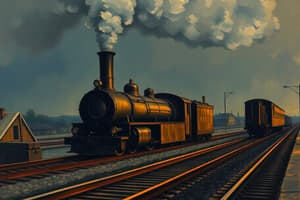Podcast
Questions and Answers
What was the nation's first big business?
What was the nation's first big business?
- Textiles
- Railroads (correct)
- Telecommunications
- Steel
Who used his money from the steamboat business to merge local railroads into the New York Central Railroad?
Who used his money from the steamboat business to merge local railroads into the New York Central Railroad?
Cornelius Vanderbilt
What are transcontinental railroads?
What are transcontinental railroads?
Railroads connecting the west and east coasts of the continental US
What caused the Financial Panic of 1893?
What caused the Financial Panic of 1893?
What major event forced ¼ of railroads to go bankrupt?
What major event forced ¼ of railroads to go bankrupt?
The American Railroad Association created 'standard time' for time zones.
The American Railroad Association created 'standard time' for time zones.
What was the Sherman Antitrust Act of 1890?
What was the Sherman Antitrust Act of 1890?
Match the following figures with their contributions:
Match the following figures with their contributions:
What concept did David Ricardo's 'iron law of wages' promote?
What concept did David Ricardo's 'iron law of wages' promote?
Which of the following was a tactic used to suppress labor unions?
Which of the following was a tactic used to suppress labor unions?
What invention did Alexander Graham Bell create in 1876?
What invention did Alexander Graham Bell create in 1876?
The Pullman Strike of 1894 was a nationwide railroad strike.
The Pullman Strike of 1894 was a nationwide railroad strike.
The ________ process was a way to manufacture steel quickly and cheaply.
The ________ process was a way to manufacture steel quickly and cheaply.
What role did the federal government play in supporting railroad companies?
What role did the federal government play in supporting railroad companies?
Study Notes
Railroads and Industrialization
- Railroads were the nation's first large scale business, pivotal in the economic landscape.
- Cornelius Vanderbilt transformed local railroads into the New York Central Railroad, creating a network of 4,500 miles.
- Eastern trunk lines served as major routes connecting cities, with smaller branches to rural areas.
Transcontinental Railroads
- Connected the East and West coasts of the United States.
- Union Pacific and Central Pacific: major companies involved in construction, utilizing significant Chinese immigrant labor.
Financial Impact and Regulation
- The American Railroad Association established standard time zones to regulate schedules in 1884.
- Speculation and overbuilding led to the Financial Panic of 1893, causing widespread railroad bankruptcies.
- J.P. Morgan capitalized on bankrupt railroads, consolidating them into seven major systems controlling two-thirds of U.S. railroads, enhancing operational efficiency.
Causes of Industrial Growth
- Abundant raw materials, a large labor supply from immigration, and a growing population fueled industrial expansion.
- New technologies and a favorable business environment promoted investment in industrial ventures.
- Talented entrepreneurs like Andrew Carnegie and John D. Rockefeller architected expansive industrial empires.
Andrew Carnegie and Steel Industry
- Carnegie established a steel monopoly through vertical integration, controlling every aspect of production.
- U.S. Steel became the first billion-dollar company under J.P. Morgan's acquisition.
John D. Rockefeller and Oil Industry
- Rockefeller's Standard Oil controlled 90% of the oil refinery market through horizontal integration.
- He created substantial wealth, reaching $900 million by retirement, utilizing market strategies like lowering prices to eliminate competition.
Technological Advances
- The Second Industrial Revolution saw innovations such as the Bessemer process for steel manufacturing.
- Alexander Graham Bell invented the telephone in 1876, revolutionizing communication.
Consumer Economy and Changes in Retail
- The rise of large department stores, such as R.H. Macy's, transformed urban shopping.
- The Sears, Roebuck catalog expanded the mail-order industry, creating a national market.
- Advertising strategies significantly contributed to the growth of a consumer economy.
Labor Movements and Industrial Discontent
- Laborers faced discontent due to harsh working conditions and low wages, leading to various strikes.
- The Knights of Labor, founded by Terence Powderly, aimed for broader reforms, including the abolition of child labor.
- The American Federation of Labor, led by Samuel Gompers, focused on skilled workers' rights and labor negotiations.
Legal and Economic Challenges
- The Sherman Antitrust Act of 1890 sought to regulate monopolies but had limited effectiveness against manufacturing practices.
- The Interstate Commerce Act aimed to regulate railroads but struggled against corrupt practices.
Social and Economic Dynamics
- Social Darwinism framed market competition as survival of the fittest, leading to racial intolerance.
- The concentration of wealth highlighted a disparity where 10% of the population controlled 90% of national wealth.
- Philanthropy became a justification for wealth accumulation, as reflected in the Gospel of Wealth doctrine.
Changing Workforce Demographics
- Immigration resulted in a growing class of factory wage earners, with many families relying on multiple incomes.
- Women's increasing participation in the workforce led to the feminization of certain jobs and wage declines.
Summary of Important Figures and Concepts
- Adam Smith advocated for laissez-faire capitalism, emphasizing minimal government interference in the economy.
- William Graham Sumner linked Social Darwinism to economic theory, influencing societal views on wealth and success.
- Horatio Alger's stories perpetuated the myth of the self-made man, presenting an idealized path from rags to riches.
Overall Economic Context
- Industrial growth in the U.S. transformed it into the world’s leading industrial power by 1900, shaping the nation’s economy and social fabric.
Studying That Suits You
Use AI to generate personalized quizzes and flashcards to suit your learning preferences.
Description
Test your knowledge of key terms from Amsco APUSH Chapter 16. This quiz covers important concepts related to the rise of the railroads and significant figures such as Cornelius Vanderbilt. Perfect for APUSH students looking to reinforce their understanding of American history.




